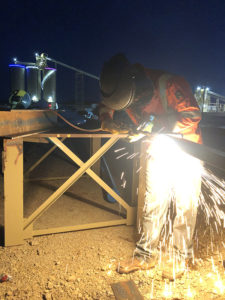Protecting Our Employees
Personal Protective Equipment and Guarding
by Leroy Faz, Safety Coordinator, Dimmit Mine
 Personal Protective Equipment
Personal Protective Equipment
In the old west, cowboys had a uniform and equipment to help them perform their work and keep them safe: cowboy hat, boots, chaps, six-shooters. At Black Mountain Sand, we have our own equipment: hard hats, safety glasses, steel-toed boots, and high visibility vests. While ours looks a bit different, it shares the similar task of keeping our employees safe while on the job. That’s called Personal Protective Equipment, PPE for short, and it’s the minimum for every person.
Some jobs require more, such as gloves, hearing protection, or other specific equipment.

Welding would be one example.
Not only is this mandated by the Mining Safety and Health Administration (MSHA, sister dept to OSHA), we ourselves are committed to keeping everyone safe with this equipment.
For this to truly protect everyone it has to be in place and secure, and we ask our people to help each other by checking to see that all their PPE is on and properly secured.
That is part of another MSHA mandated procedure, the 360˚ workplace examination, which we do before starting any job. It makes sure that we have everything we need and that there’s nothing in the way of getting the job done safely. That includes our PPE.
Someone might think that verifying our PPE would only need to happen at the start of the shift. However, there are intervals (such as lunch breaks and moving to a different area) where adjustments can be checked. Someone might be tempted to loosen some equipment while between tasks, such as a full body harness, or part of a vest could come undone in transit. So, we can’t skip that step at any point of the shift. That’s how important PPE is to everyone’s safety.
As with all safety procedures, we offer reminders and 5-10-minute trainings at the start of a seven-day shift using the Toolbox Talks every day. Several times through the year we’ll bring in outside experts to cover certain topics and to get a fresh view of procedures, to help people remember safety procedures for every job, every minute of every day.
Maybe this sounds a little over the top, but like most of my safety colleagues, I’ve seen what happens when someone forgets even a small detail. Unfortunately, when a seemingly small thing goes wrong, the effects are not always confined to just the one who forgot. This is why we stress that safety is everyone’s job.
 Protective Devices and Guarding
Protective Devices and Guarding
While PPE on a person is crucial, our machinery needs protective equipment as well. A procedure called Guarding involves putting guards or covers over anything that moves in a way that could snag hands, feet, even hair. Personnel are trained to never modify, bypass, or remove a protective device. Because of the huge volumes of sand we move every day, all of our equipment is very powerful—anyone caught in this machinery would be in great danger. 
The only time we remove guards is to work on the machine. In that situation, we employ the Lock Out / Tag Out / Try Out procedure, in which everyone involved makes sure that the power is off and tested before removing the guard and starting repairs.
Almost all incidents are preventable, and we’re doing everything we can to help our people work as a team to inspect, communicate and re-check every job to make it as safe as possible.

